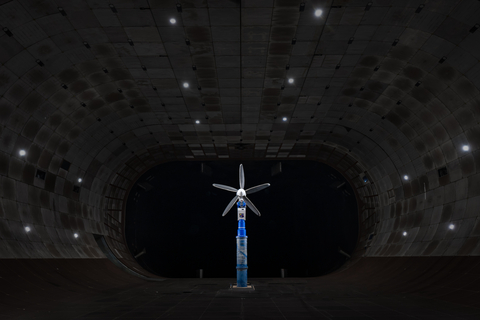Joby Begins Testing at World’s Largest Wind Tunnel Facility
Joby Aviation (NYSE:JOBY) has commenced testing its electric vertical take-off and landing (eVTOL) aircraft propeller at NASA's National Full-Scale Aerodynamic Complex (NFAC), the largest wind tunnel facility globally. This pivotal testing phase aims to provide vital data for the aircraft's certification with the Federal Aviation Administration (FAA). Joby expects the tests to yield superior data quality, enhancing its commercial aviation rollout planned for 2025. With over 1,000 test flights completed, Joby's aircraft aims for zero emissions and rapid urban air transport.
- Testing at NFAC enhances data collection for propeller performance.
- Joby is likely the first eVTOL company to utilize NFAC for propeller testing.
- Testing supports FAA certification, crucial for commercial operations.
- Plans to launch commercial aerial ridesharing service by 2025.
- None.
Insights
Analyzing...

A Joby propeller installed at the
The NFAC, managed by the
Joby is believed to be the first electric vertical take-off and landing (eVTOL) company to test its propeller in the NFAC’s 40-by-80 foot wind tunnel.
“Testing is a critical part of our aircraft program and the opportunity to gather data on the performance of our propellers in one of the world’s largest wind tunnels is an exciting step toward commercialization,” said
“This facility helped introduce historic aircraft to the world, and now it’s doing the same for the next generation of sustainable aviation,” he added.
Lt Col
The test campaign will cover all tilt angles and speeds through the expected flight envelope, providing Joby with consistent and high-fidelity data on the performance, loads, and acoustics of its propeller systems in support of its certification program with the
Working in partnership with the
The NFAC propeller test campaign is expected to produce data of unparalleled quality – exceeding what is captured during normal flight testing – due to superior instrumentation and precise control of variables. The full test campaign is expected to take several months to complete.
Joby and NASA previously partnered on a variety of projects exploring electric aircraft technology, including the design of the agency’s all-electric X-57 Maxwell prototype. The agency also completed a two-week acoustic testing program with Joby in 2022 as part of NASA’s Advanced Air Mobility National Campaign.
With more than 1,000 test flights completed, Joby’s piloted, all-electric aircraft is designed to offer a faster and quieter method of aerial transportation across cities and communities with zero operating emissions. Joby expects to launch commercial aerial ridesharing service in
About Joby
Forward Looking Statements
This press release contains “forward-looking statements” within the meaning of the “safe harbor” provisions of the Private Securities Litigation Reform Act of 1995, including but not limited to, statements regarding the development and performance of our aircraft, including our expectation to start commercial passenger service in 2025, the expected benefits of our testing program with NFAC; and our current expectations relating to our business. You can identify forward-looking statements by the fact that they do not relate strictly to historical or current facts. These statements may include words such as “anticipate”, “estimate”, “expect”, “project”, “plan”, “intend”, “believe”, “may”, “will”, “should”, “can have”, “likely” and other words and terms of similar meaning in connection with any discussion of the timing or nature of future operating or financial performance or other events. All forward looking statements are subject to risks and uncertainties that may cause actual results to differ materially, including: our ability to launch our aerial ridesharing service and the growth of the urban air mobility market generally; our ability to produce aircraft that meet our performance expectations in the volumes and on the timelines that we project, and our ability to launch our service; the competitive environment in which we operate; our future capital needs; our ability to adequately protect and enforce our intellectual property rights; our ability to effectively respond to evolving regulations and standards relating to our aircraft; our reliance on third-party suppliers and service partners; uncertainties related to our estimates of the size of the market for our service and future revenue opportunities; and other important factors discussed in the section titled “Risk Factors” in our Annual Report on Form 10-K, filed with the
View source version on businesswire.com: https://www.businesswire.com/news/home/20230216005794/en/
Investors:
investors@jobyaviation.com
Media:
press@jobyaviation.com
Source:






